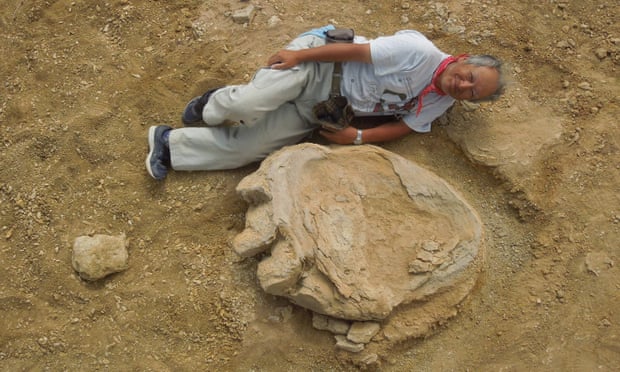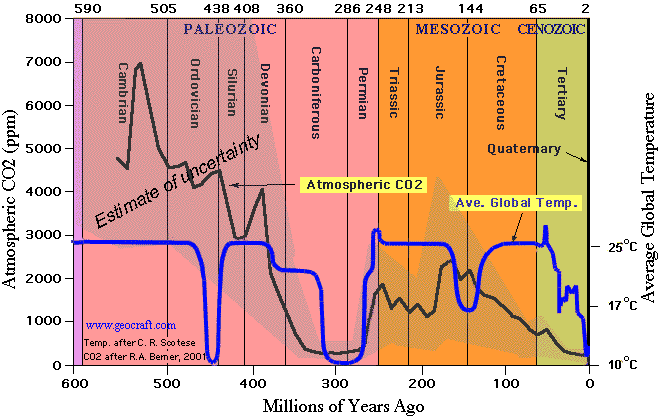Discussion
It's time we had a section on paleontology in the science section.
New discoveries and theories are emerging all the time. The latest bit of news is this enormous footprint found in the Gobi Desert by a joint Japanese/Chinese expedition -

They think it would have been made by an animal like this - a giant sauropod -

New discoveries and theories are emerging all the time. The latest bit of news is this enormous footprint found in the Gobi Desert by a joint Japanese/Chinese expedition -

They think it would have been made by an animal like this - a giant sauropod -

LandR said:
Probably a dumb question... but... why don't we have any land animals nowadays as large as the bigger dinosaurs?
Not a dumb question at all. Dinosaurs tended to have very lightweight bone structures so, for their size, they were lighter than an equivalent sized mammal would be. Dinosaur physiology was closer to birds than to mammals or modern reptiles.African elephant is about as large as a mammal's bone structure can support on land.
Another driver for size was the type of plants that existed for most of the dinosaur era. On the whole, these plants were tough, non-flowering types which were difficult to digest. Huge stomach and guts were required to slowly break down this tough vegetable matter.
Higher oxygen levels promoted increased plant and tree growth, so you have massive, high plants that nature then had to provide much bigger animals to get at.
That's the best I can come up with, think that's about right as there were massive insects as a result too, dragon flies that genuinely deserved the name for example.
That's the best I can come up with, think that's about right as there were massive insects as a result too, dragon flies that genuinely deserved the name for example.
Thunderhead said:
Higher oxygen levels promoted increased plant and tree growth, so you have massive, high plants that nature then had to provide much bigger animals to get at.
That's the best I can come up with, think that's about right as there were massive insects as a result too, dragon flies that genuinely deserved the name for example.
I don't think oxygen levels in the dinosaur era (250 to 65 million years ago) were much different compared to today. That's the best I can come up with, think that's about right as there were massive insects as a result too, dragon flies that genuinely deserved the name for example.
Oxygen levels HAD been higher in earlier times. During the Carbiniferous period (400 - 300 million years ago) that was definitely the case - and it allowed massive land dwelling invertebrates - such as cow sized millipede and albatross sized dragonflies to exist.
Eric Mc said:
LandR said:
Probably a dumb question... but... why don't we have any land animals nowadays as large as the bigger dinosaurs?
Not a dumb question at all. Dinosaurs tended to have very lightweight bone structures so, for their size, they were lighter than an equivalent sized mammal would be. Dinosaur physiology was closer to birds than to mammals or modern reptiles.African elephant is about as large as a mammal's bone structure can support on land.
Danattheopticians said:
True about the physiology, however, does this really explain why animals ie not specifically mammals, do not exist on earth today. There must be more to explain it that physiology differences alone. Is the climate different, is it lack of food stuff for them? Because the physiology to allow dinosaurs sized animals existed in the past but what has changed/which change specifically has stopped any animals that large to have evolved and exist again?
See my comment above the types of plants that existed back then. Also, dinosaurs, being bird like, did not evolve the same digestion and break down methods that mammals did.Mammals have a number of attributes different to dinosaurs regarding how they eat and digest food. Firstly, they can chew (i.e. move their lower jaw from side to side). This has a big effect on breaking the food down before it is sent to the stomach. As a result, food does not have to rest in the stomach and other intestines for a long time in order for the nutrients to be absorbed by the bloodstream.
Also, some mammals (the ruminants) have evolved a form of double stomach which breaks intestinal digestion into two elements. Many of these animals can also return part digested food to the mouth for a second or third go at mastication (commonly known as "chewing the cud").
As far as we know, dinosaurs could not do any of this. In an era when plant life was fairly tough, the only way to break it down was to retain it in the stomach and guts for long periods of time - effectively using the stomach as a fermentation vat. The bigger the stomach the better the fermenation. That encouraged large size.
We also know that some dinosaurs (such as the big sauropods) had a gizzard - which is a pocket in the neck where food can be broken down by stones swallowed in advance. Many birds (such as chickens and ostriches) do this all the time.
Some (not all, of course) of the predators living off these herbivores also grew large. It was a kind of dino arms race.
What is interesting is that, towards the end of the dinosaur era (65 million) softer, flowering plants had evolved and consequently, many of the herbivores were not as big as (say) those that had lived in the Jurassic or Early Cretaceous.
It also seems that some herbivores, such as the duck billed dinosaurs, had evolved a more flexible way of biting and masticating their food. Whilst they couldn't chew like a mammal, some of them had flexible plates in their jaw which created a sort of chewing action.
Thunderhead said:
Higher oxygen levels promoted increased plant and tree growth, so you have massive, high plants that nature then had to provide much bigger animals to get at.
That's the best I can come up with, think that's about right as there were massive insects as a result too, dragon flies that genuinely deserved the name for example.
High oxygen levels would be a result of increased plant growth, higher CO2 levels would promote it.That's the best I can come up with, think that's about right as there were massive insects as a result too, dragon flies that genuinely deserved the name for example.
welshjon81 said:
Dinosaurs aren't real! Their remains were put on this earth by the lord to test our faith!!!
You will all burn in hell if you believe this nonsense!
Wrong. They were taken aboard Noah's Ark along with the other animals including the 2 penguins that walked/waddled all the way to the Middle East from Antarctica for instance. Read your Bible people!You will all burn in hell if you believe this nonsense!
OK, serious question?
Other than by linking fossilised bones together and comparing them to those of animals that exist today. Plus there is some evidence of some feathers on certain species and some teeth and stuff, how much can we really determine from this rather limited amounts of knowledge?
So: Can we determine skin colour and markings and were and able to change colour like a chameleon?
Do we know for sure how, for example raptors would have hunted in packs?
How accurately can we determine their diets?
What did they sound like? Roars, mating calls etc?
It's only in more recent years we have come to believe the Tyrannosaurus Rex could more likely have been a scavenger rather than a predator, but can we ever know for sure?
Other than by linking fossilised bones together and comparing them to those of animals that exist today. Plus there is some evidence of some feathers on certain species and some teeth and stuff, how much can we really determine from this rather limited amounts of knowledge?
So: Can we determine skin colour and markings and were and able to change colour like a chameleon?
Do we know for sure how, for example raptors would have hunted in packs?
How accurately can we determine their diets?
What did they sound like? Roars, mating calls etc?
It's only in more recent years we have come to believe the Tyrannosaurus Rex could more likely have been a scavenger rather than a predator, but can we ever know for sure?
Eric Mc said:
No evidence that either Oxygen or CO2 were much different to today in the period the dinosaurs lived.
If this graphic and the data it is based on are to be believed - CO2 levels in the Triassic and Jurassic periods hovered around the 2000ppm mark (~4 times what it is today) and the average global temperature was much warmer too. CO2 levels dropped off during the Cretaceous - but even at the end of that period, it was still around double what it is today.
Gassing Station | Science! | Top of Page | What's New | My Stuff





